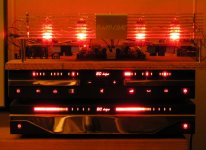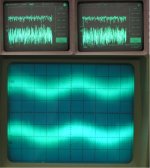Hi Bernhard,
Thanks for your reply [post#359]
Sorry for the mix-up, seems I need some rest. As I already explained to tubee, I am making a lot of misstakes lately. Thanks for the link to the audio test file. I have already downloaded it, and I will post oscillograms as soon as I have tried it.
Thanks for your reply [post#359]
Sorry for the mix-up, seems I need some rest. As I already explained to tubee, I am making a lot of misstakes lately. Thanks for the link to the audio test file. I have already downloaded it, and I will post oscillograms as soon as I have tried it.
new prototype in action
Hi all,
I have mounted the tube module / frame on the prototype board, using a new setup. I arranged components the way I plan to place them in the housing. Connections are kept as short as possible. Taking dddac's advice I added frequency compensation on the attenuators / interlinks as I couldn't lower impedance much more due to the tube output stage. Now both attenuators and interlink capacitance are compensated.
The tube stages seem to function beyond expectation on the PCB's, they are stable, output signal is clean (I was afraid of both, crosstalk and oscillations). The protective grid does a marvelous screening job when earthed.
I listened to this setup till deep in the night, seems the compact setup with shorter connections made some improvements in clarity and interference reduction.
I added a night photograph of the new prototype setup in action
Hi all,
I have mounted the tube module / frame on the prototype board, using a new setup. I arranged components the way I plan to place them in the housing. Connections are kept as short as possible. Taking dddac's advice I added frequency compensation on the attenuators / interlinks as I couldn't lower impedance much more due to the tube output stage. Now both attenuators and interlink capacitance are compensated.
The tube stages seem to function beyond expectation on the PCB's, they are stable, output signal is clean (I was afraid of both, crosstalk and oscillations). The protective grid does a marvelous screening job when earthed.
I listened to this setup till deep in the night, seems the compact setup with shorter connections made some improvements in clarity and interference reduction.
I added a night photograph of the new prototype setup in action
Attachments
dem reclock noises?
With a 2nd disc, i think i heard indeed some extra distorsion edges on the sound, but this could be from music also (Depeche mode, Playing the angel, they mixed a lot of "extra effects" on this CD) With the first disc (all kind of music, eg Bill Whiters) i did not hear that noises. I think i have to upgrade dem-reclock to your version ECdesigns, but first solve the keyboard problems.
Ecdesigns: the blue caps, are they Philips MKC's? I like them, after PIO they are quite good.
Thanks for the tip to upgrade the opamps. I have 2 OP275's lying here too, but i didn't like them, too bass-shy. And as a bass-freak, i fortunately got a huge 15 inch bass speaker for free, will build a nice sub around it. Am dreaming of 20Hz allready...

With a 2nd disc, i think i heard indeed some extra distorsion edges on the sound, but this could be from music also (Depeche mode, Playing the angel, they mixed a lot of "extra effects" on this CD) With the first disc (all kind of music, eg Bill Whiters) i did not hear that noises. I think i have to upgrade dem-reclock to your version ECdesigns, but first solve the keyboard problems.
Ecdesigns: the blue caps, are they Philips MKC's? I like them, after PIO they are quite good.
Thanks for the tip to upgrade the opamps. I have 2 OP275's lying here too, but i didn't like them, too bass-shy. And as a bass-freak, i fortunately got a huge 15 inch bass speaker for free, will build a nice sub around it. Am dreaming of 20Hz allready...
Re: Re: Re: octal D-I DAC improvements
Fully agree, do that regulary; just spent a great evening at the Berliner Philharmoniker this weekend ....
doede
stefanobilliani said:
You have to go to a theater and listen to an orkestra or a live band to "know" how the huge difference is realistic or not . Sclaed out through your favourite listening parameters; Then , also how you are prepared to receive music is important Becouse the music "hosts" you if you are prepared , otherwise it will let you away .
Fully agree, do that regulary; just spent a great evening at the Berliner Philharmoniker this weekend ....
doede
Hi Bernhard,
Thanks for your reply [post#359 / #365],
Here are the FFT scans of the -60dB dithered 1KHz sinewave, as promised. Top left, octal D-I DAC, Top right CD player with digital filter and oversampling. I can't see much difference, note that the displayed spectrum keeps moving. Probably limitations of the tektronics digital oscilloscope. I also added a oscillogram, perhaps this shows a little more. Upper track, octal D-I DAC, lower track CD player with digital filter and oversampling. Note the octal D-I DAC is unfiltered, the CD player with digital filter and oversampling is.
Thanks for your reply [post#359 / #365],
Here are the FFT scans of the -60dB dithered 1KHz sinewave, as promised. Top left, octal D-I DAC, Top right CD player with digital filter and oversampling. I can't see much difference, note that the displayed spectrum keeps moving. Probably limitations of the tektronics digital oscilloscope. I also added a oscillogram, perhaps this shows a little more. Upper track, octal D-I DAC, lower track CD player with digital filter and oversampling. Note the octal D-I DAC is unfiltered, the CD player with digital filter and oversampling is.
Attachments
-ecdesigns- said:Hi Bernhard,
Thanks for your reply [post#359 / #365],
Here are the FFT scans of the -60dB dithered 1KHz sinewave, as promised. Top left, octal D-I DAC, Top right CD player with digital filter and oversampling. I can't see much difference, note that the displayed spectrum keeps moving. Probably limitations of the tektronics digital oscilloscope. I also added a oscillogram, perhaps this shows a little more. Upper track, octal D-I DAC, lower track CD player with digital filter and oversampling. Note the octal D-I DAC is unfiltered, the CD player with digital filter and oversampling is.
EC, try some BW limiting above 100k or so. The scope traces will
probably reveal a lot more. The scope is just showing ultra wide
BW noise. Since the peak to rms of noise is very high (up to 6 x)
the traces get flooded.
Even so, the D-I dac trace looks good.
If you play the -60dB signal, it is quite audible, makes you
realise how much we can hear down there, especially if a CD
has not been squashed (compressed) too much.
Cheers,
Terry
-ecdesigns- said:Hi Bernhard,
Thanks for your reply [post#359 / #365],
Here are the FFT scans of the -60dB dithered 1KHz sinewave, as promised. Top left, octal D-I DAC, Top right CD player with digital filter and oversampling. I can't see much difference, note that the displayed spectrum keeps moving. Probably limitations of the tektronics digital oscilloscope. I also added a oscillogram, perhaps this shows a little more. Upper track, octal D-I DAC, lower track CD player with digital filter and oversampling. Note the octal D-I DAC is unfiltered, the CD player with digital filter and oversampling is.
EC,
Is there any chance you can get a scope shot of the non D-I 0 x OS
dac at same -60dB OP for comparison?
Thanks
Terry
Bernhard said:EC,
You could bring the cure, I'm sure
If he does, will he get his bicycle back ?
jean-paul said:That one has a beard by now Ray. We do not want the bicycle, we want victory at the world championship.
Well you've got your work cut out for you in a few days (Argentina)...
The horrible DAC
Hi all,
Seems as if the octal D-I DAC should sound horrible according to all kind of theories. It's kind of funny reading these, while listening to the beautiful sound of this DAC. Especially after lowering the output impedance to 590 Ohms. Yes I take critics seriously [post#338] and use them to improve the octal D-I DAC design, that's getting better all the time, thanks dddac. The noise in the last oscillograms was mainly caused by high frequency lighting and switch-mode supplies, it had nothing to do with the octal D-I DAC, oscilloscope or standard CD player. The -60dB dithered 1KHz "noisy" sinewave was clearly audible and sounded like a sinewave, so what's the problem?
First of all, this is a NOS-DAC and has limitations to produce perfect sinewaves at high frequencies, the absence of a brickwall filter causes even more problems when approaching fs, spreading harmonics all over the splace. The direct interpolation adds errors, so the octal D-I DAC should be about the worst DAC imaginable in theory. Then there are the (Differential) linearity errors of 8 DAC's and the inferior TDA1541A R1 types. But since 8 DAC chips are used, fine tuning [post#365] can be achieved by swapping DAC chips between group 1,3,5,7 and group 2,4,6,8 to obtain lowest possible (differential) linearity errors with the chips available.
When building a NOS-DAC there is one very good reason to do so, phase linearity. Compared to a conventional DAC, brickwall filter and all, it seems that this DAC still has it's limitations when taking sound quality into account. Since the end result is achieving natural transparent sound, it's not a bad idea to focus on the actual produced sound quality, rather than building a DAC using theoretical considerations only.
The NOS twin DAC I built years ago, solved the harmonics problem (main problem with NOS-DAC's [post#119]), it often causes a harsh sound that can be corrected to some extent by filtering. I used a 8th order butterworth filter. It partially solved the problem but introduced a new one: filtering and the accompanied phase errors. But despite this filter it still outperformed many high quality CD players.
So the question was, how to achieve a similar effect (correcting the harsh sound) without filtering. Here is where direct interpolation can offer a solution. It produces higher resolution (less problems with harmonics) [post#121] without the 8th order butterworth filter, and preserving phase linearity.
What about linearity errors? When listening to various setups, phase errors seem to be far worse than linearity errors. Even a "phase linear" 2nd order Bessel filter already causes clearly audible sound changes. The total of all (introduced) errors produce mainly odd harmonics as semiconductors are used. To compensate for this, I added the tube output stage (mainly even harmonics). By mixing semiconductor and tube output signal in a specific ratio, the harmonic spectrum can be balanced. When this balance is established, a significant improvement in sound quality can be achieved.
Hi all,
Seems as if the octal D-I DAC should sound horrible according to all kind of theories. It's kind of funny reading these, while listening to the beautiful sound of this DAC. Especially after lowering the output impedance to 590 Ohms. Yes I take critics seriously [post#338] and use them to improve the octal D-I DAC design, that's getting better all the time, thanks dddac. The noise in the last oscillograms was mainly caused by high frequency lighting and switch-mode supplies, it had nothing to do with the octal D-I DAC, oscilloscope or standard CD player. The -60dB dithered 1KHz "noisy" sinewave was clearly audible and sounded like a sinewave, so what's the problem?
First of all, this is a NOS-DAC and has limitations to produce perfect sinewaves at high frequencies, the absence of a brickwall filter causes even more problems when approaching fs, spreading harmonics all over the splace. The direct interpolation adds errors, so the octal D-I DAC should be about the worst DAC imaginable in theory. Then there are the (Differential) linearity errors of 8 DAC's and the inferior TDA1541A R1 types. But since 8 DAC chips are used, fine tuning [post#365] can be achieved by swapping DAC chips between group 1,3,5,7 and group 2,4,6,8 to obtain lowest possible (differential) linearity errors with the chips available.
When building a NOS-DAC there is one very good reason to do so, phase linearity. Compared to a conventional DAC, brickwall filter and all, it seems that this DAC still has it's limitations when taking sound quality into account. Since the end result is achieving natural transparent sound, it's not a bad idea to focus on the actual produced sound quality, rather than building a DAC using theoretical considerations only.
The NOS twin DAC I built years ago, solved the harmonics problem (main problem with NOS-DAC's [post#119]), it often causes a harsh sound that can be corrected to some extent by filtering. I used a 8th order butterworth filter. It partially solved the problem but introduced a new one: filtering and the accompanied phase errors. But despite this filter it still outperformed many high quality CD players.
So the question was, how to achieve a similar effect (correcting the harsh sound) without filtering. Here is where direct interpolation can offer a solution. It produces higher resolution (less problems with harmonics) [post#121] without the 8th order butterworth filter, and preserving phase linearity.
What about linearity errors? When listening to various setups, phase errors seem to be far worse than linearity errors. Even a "phase linear" 2nd order Bessel filter already causes clearly audible sound changes. The total of all (introduced) errors produce mainly odd harmonics as semiconductors are used. To compensate for this, I added the tube output stage (mainly even harmonics). By mixing semiconductor and tube output signal in a specific ratio, the harmonic spectrum can be balanced. When this balance is established, a significant improvement in sound quality can be achieved.
Dear ecdesigns:
Don't get angry.
Work tranquilly.
The "ethernal beginner's guild" suppports you
We believe NOS DAC's transmit the soul of music but we are unable ourselves to deal with the inconvenients you listed above.
We are expecting good things from your aproach.
Best regards
M
PS: and take some rest from time to time
Seems as if the octal D-I DAC should sound horrible according to all kind of theories.
Don't get angry.
Work tranquilly.
The "ethernal beginner's guild" suppports you

We believe NOS DAC's transmit the soul of music but we are unable ourselves to deal with the inconvenients you listed above.
We are expecting good things from your aproach.
Best regards
M
PS: and take some rest from time to time

Yes take some rest Ecdesigns, you did a great job in relative short time. I do years about one modification....
The dem reclock, your written version, gives a clear sound, no additional noises(coupled with a 100pf cap on pin 16) I hear some resembling with the non-os player, though it has still os. Might profit from A-S1 dac. But still the fault is there.
Btw your proposed BB opamps are on their way by Fedex.
Thanks, and drink some or more , you earned it by now.
, you earned it by now.
The dem reclock, your written version, gives a clear sound, no additional noises(coupled with a 100pf cap on pin 16) I hear some resembling with the non-os player, though it has still os. Might profit from A-S1 dac. But still the fault is there.
Btw your proposed BB opamps are on their way by Fedex.
Thanks, and drink some or more
 , you earned it by now.
, you earned it by now.Dear EC,
I believe linearity is very important, and the problem is in the low level.
@ 0 dB all DACs are good.
Some people say you can't hear it but it is not true. A DAC with good low level linearity sounds more pure and smooth and has better resolution, no matter os or non-os.
If one hears a more black background which means less noise, usually from a high bit DAC, one also must hear the distortion because the harmonics are far above the noise floor especially in DACs > 16bit.
The distortion gets more noticable with more bits = less noise.
On your FFT unfortunately there is nothing to see, not even the fundamental 1 kHz.
I made another -60dB measurement of a selected PCM56, about one out of 30 is that good with careful made MSB adjust.
The PCM56 is in a Yamaha player that fakes 18bit from the 16bit chip, just like the CD304 fakes 16 bit from the TDA1540, which also reduces noise.
This graph is with 16 x averaging to cancel the noise and see what happens under the noise floor.
The horizontal cursor line marks the level of the worst harmonic which is -64dB relative to the input signal.
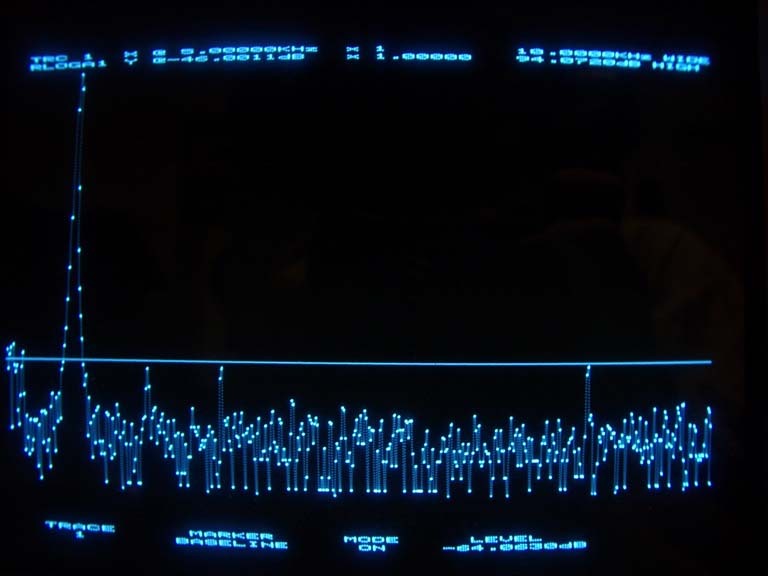
.
.
.
And this is without averaging, the noise floor is -60dB, so there is nothing to see, harmonics are 4 dB down under and would be even more hidden in a standard 16 bit player.
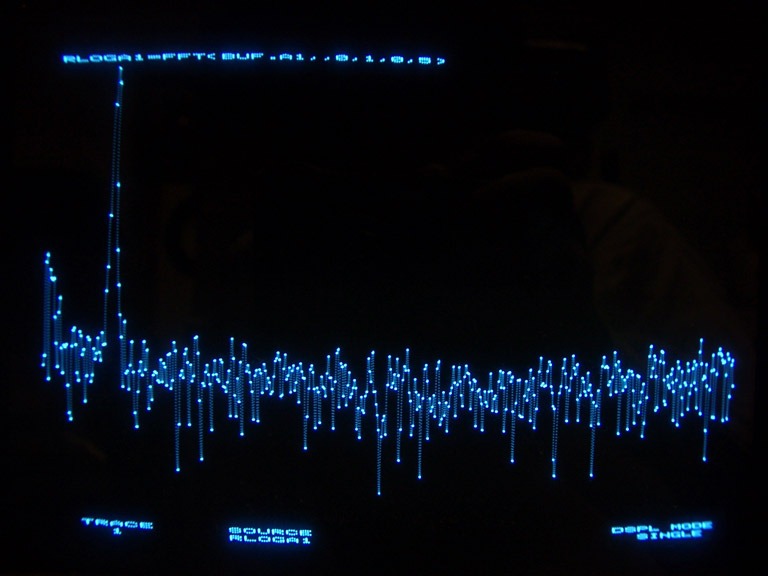
.
.
.
Did you think about adding MSB adjust to the TDA ?
A normal TDA1541A usually produces a strong dominant K5 that will be somewhere between -50dB and -55dB.
Unfortunately I have no TDA1541A graph to show and no chip to measure either, here are both channels of a plain 1541 with 4 x os in a Philips CD960, the even order harmonics usually are less in other players, that is a general flaw of the 960.
But the values for K3 on the cursor line are realistic.
-51,3dB and -58,8 dB.
As you also can see, left and right channel look different and will sound different which can disturb sound stage.
With 1541A in standard non-os ( skipping the SAA7220 ), the dominant K5 turns into something like shown in the graph, more evenly distributed harmonics which means all K2 up to K9 around -50dB.
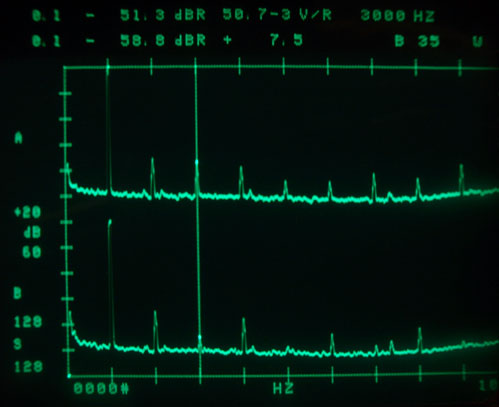
I believe linearity is very important, and the problem is in the low level.
@ 0 dB all DACs are good.
Some people say you can't hear it but it is not true. A DAC with good low level linearity sounds more pure and smooth and has better resolution, no matter os or non-os.
If one hears a more black background which means less noise, usually from a high bit DAC, one also must hear the distortion because the harmonics are far above the noise floor especially in DACs > 16bit.
The distortion gets more noticable with more bits = less noise.
On your FFT unfortunately there is nothing to see, not even the fundamental 1 kHz.
I made another -60dB measurement of a selected PCM56, about one out of 30 is that good with careful made MSB adjust.
The PCM56 is in a Yamaha player that fakes 18bit from the 16bit chip, just like the CD304 fakes 16 bit from the TDA1540, which also reduces noise.
This graph is with 16 x averaging to cancel the noise and see what happens under the noise floor.
The horizontal cursor line marks the level of the worst harmonic which is -64dB relative to the input signal.
.
.
.
And this is without averaging, the noise floor is -60dB, so there is nothing to see, harmonics are 4 dB down under and would be even more hidden in a standard 16 bit player.
.
.
.
Did you think about adding MSB adjust to the TDA ?
A normal TDA1541A usually produces a strong dominant K5 that will be somewhere between -50dB and -55dB.
Unfortunately I have no TDA1541A graph to show and no chip to measure either, here are both channels of a plain 1541 with 4 x os in a Philips CD960, the even order harmonics usually are less in other players, that is a general flaw of the 960.
But the values for K3 on the cursor line are realistic.
-51,3dB and -58,8 dB.
As you also can see, left and right channel look different and will sound different which can disturb sound stage.
With 1541A in standard non-os ( skipping the SAA7220 ), the dominant K5 turns into something like shown in the graph, more evenly distributed harmonics which means all K2 up to K9 around -50dB.

This is all getting to complex for me 
I trust the project by EC designs, simply by the fact that I can not do anything near it myself. It seems logical there will be critics on the use of the TDA1541A...the ones I bought recently are about 20 years old...sure better 'measured' perfomance is obtained using newer chips. But still, I listened to a TDA1541A and loved it...just like I also like tubes, which also have worse performance than sand.
As I said, it is getting to complex, but it seems that there is coming some nice input from Bernhard on how to improve things further. I encourage all of you to put the heads together and think about it! I will wait to see the result - I won't say the end result, because there never is an end!
Erik

I trust the project by EC designs, simply by the fact that I can not do anything near it myself. It seems logical there will be critics on the use of the TDA1541A...the ones I bought recently are about 20 years old...sure better 'measured' perfomance is obtained using newer chips. But still, I listened to a TDA1541A and loved it...just like I also like tubes, which also have worse performance than sand.
As I said, it is getting to complex, but it seems that there is coming some nice input from Bernhard on how to improve things further. I encourage all of you to put the heads together and think about it! I will wait to see the result - I won't say the end result, because there never is an end!
Erik
Bernhard said:MSB adjust could be done by isolating the MSB from the data stream with a serial to parallel shift register and let the MSB switch a small fine adjustable current ( connected to the Iout of the TDA ) on and off.
I have seen that in an old Technics and it works.
Not very practical, given the current circumstances.
- Home
- Source & Line
- Digital Line Level
- Building the ultimate NOS DAC using TDA1541A
